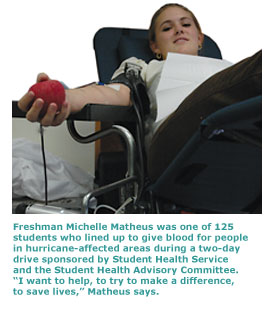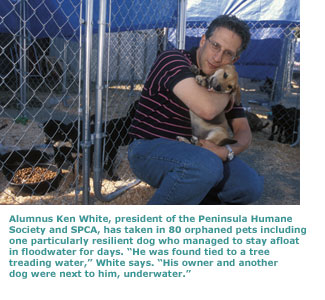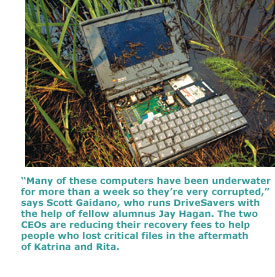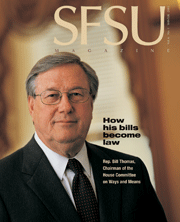Galjour is one of many on campus who spent the fall semester doing what they could to help the Gulf Coast region get back on its feet. Teaming with San Francisco's Z Space Studio, she has performed her one-woman show at theatres in Berkeley, San Francisco, Santa Fe and Seattle, with proceeds going to Habitat for Humanity and arts organizations throughout New Orleans. "If theatres can't come back, artists can't come back," Galjour says. "We need to get New Orleans up and running -- and it needs to come back with its character intact."
 Pitching in is also a personal cause for SFSU Artist-in-Residence Branford Marsalis. He and fellow jazz great Harry Connick Jr., both native New Orleanians, are co-chairing Habitat for Humanity's efforts to rebuild homes in decimated areas. "I think that with an organization like Habitat, it can make a very big dent," he told Matt Lauer during a September visit to NBC's "Today" show.
Pitching in is also a personal cause for SFSU Artist-in-Residence Branford Marsalis. He and fellow jazz great Harry Connick Jr., both native New Orleanians, are co-chairing Habitat for Humanity's efforts to rebuild homes in decimated areas. "I think that with an organization like Habitat, it can make a very big dent," he told Matt Lauer during a September visit to NBC's "Today" show.
University residence halls are abuzz with efforts to help the displaced. Residence hall advisers have organized students to volunteer at Bay Area American Red Cross chapters, and raised funds through root beer float sales and coin drives. Freshman Jill Bergantz's volunteer efforts were inspired by a San Francisco Chronicle story about quilters. "Even though such horrible things were happening, people were making beauty come from chaos," she says. "Women were crafting quilts to send to survivors, and I wanted to help them do it." Bergantz contacted her residence adviser, sophomore Kimberly Allen, who bought fabric and organized a meeting of residents from the Towers at Centennial Square and Mary Ward and Mary Park halls. Together they cut squares of fabric and stitched them together. In late September Bergantz hand-sewed the binding on their first quilt and sent it to the American Red Cross.
Students Fay Eastman and Sara Henderson decided to send themselves to the disaster area. The two friends joined other American Red Cross volunteers in distributing supplies to the displaced in Beaumont, Texas. Meanwhile, Meredith Duke, the budget coordinator for SFSU's Academic Resources Department, is on standby with the organization, awaiting her deployment to the Gulf Coast region. Duke, who grew up in Alabama, has visited New Orleans many times. "Loving that city so much, I was heartbroken to see photos of the devastation ⦠residents on their rooftops waiting for help ⦠stories of grandmothers and children disappearing into the deep water which had been their neighborhoods. I just felt I had to go."
 In early September, De Tran (B.A., '87), editor and publisher of San Jose's VietMercury newspaper, flew to Biloxi, Miss. to serve as a translator in the area's Vietnamese community. "They are mostly poor folks ⦠a lot don't speak fluent English," Tran says of Biloxi's estimated 2,000 displaced Vietnamese, many of whom worked in the fishing industry and lost jobs and homes to Katrina.
In early September, De Tran (B.A., '87), editor and publisher of San Jose's VietMercury newspaper, flew to Biloxi, Miss. to serve as a translator in the area's Vietnamese community. "They are mostly poor folks ⦠a lot don't speak fluent English," Tran says of Biloxi's estimated 2,000 displaced Vietnamese, many of whom worked in the fishing industry and lost jobs and homes to Katrina.
"I've never seen anything like that in my life ⦠everything wiped out. The destruction was unimaginable," Tran says. The people he encountered on his trip were no strangers to difficult times. A large population of residents fled to the Gulf Coast following the Vietnam War. "I think the most heartbreaking thing was that for many people who lost everything, this was the second time in their lives this had happened," Tran says.
As translator, he assisted residents with filling out forms for FEMA and he also lent a hand to the rebuilding effort. Tran tore out sheet rock to prevent mold in Biloxi's Van Duc Buddhist Temple, which sustained a great deal of water damage but remains standing. In the weeks following Katrina, some 200 residents found shelter in the temple while others remained adrift on fishing boats.
Some of the people SFSU has helped are right here on campus. The University has offered students whose academic lives were disrupted by Hurricane Katrina a chance to continue their education, and enroll even without transcripts, and pay only in-state fees. To date, seven evacuees from the Gulf Coast area have enrolled in classes on campus, including Jonah Purinton.
In August, a day and a half before Hurricane Katrina hit the Gulf Coast, Purinton, then a junior college student in Gulfport, Miss. reluctantly threw a few shirts into a bag, hopped in his car and drove away from Katrina's projected path. In Miss., he had grown accustomed to frequent storm warnings and he expected to return to Gulfport in a few days. When he reached Jacksonville, Fla., he turned on the television news and saw that his town was underwater.
Leaving his home and friends hasn't been easy, but Purinton is grateful to SFSU for helping him reconnect with his education. "People here have been really nice; they really helped me out," he says, pointing to Ernie Scosseria, associate director of undergraduate admissions, who expedited his admissions process, explained financial aid options and identified classes with available space. Purinton also appreciated the efforts of Rob Strong (B.S., '84; M.B.A., '90), general manager of the SFSU Bookstore, which provided Purinton with a full scholarship for his textbooks and school supplies.
Approximately 600 families who were forced to leave their homes throughout the Gulf Coast region made their way to San Francisco in the weeks following Katrina. Brian Cahill (M.S.W., '68), executive director of Catholic Charities CYO, worked with partners throughout the city to provide at least half of these families with counseling services and support. His team helped arrange transportation to hospitals, pharmacies and hotels and provided bus and airline tickets to those who needed to reunite with family far away.
 Ken White (attended '75-'78) is helping the furry and four-legged hurricane survivors. The president of the Peninsula Humane Society and Society for the Prevention of Cruelty to Animals has been working 70-hour weeks since the first batch of orphaned animals arrived on the organization's doorstep mid-September. White's staff has taken in 74 dogs, six cats and two rabbits. Many are being housed in a temporary shelter that White's staff erected in the parking lot. They will continue to accommodate as many pets as possible. "If we end the year in a deficit, then we'll end the year in a deficit," White explains. "We're going to do the right thing." To date, the organization has helped seven dogs reunite with their owners while 500 volunteers have expressed interest in housing other pets.
Ken White (attended '75-'78) is helping the furry and four-legged hurricane survivors. The president of the Peninsula Humane Society and Society for the Prevention of Cruelty to Animals has been working 70-hour weeks since the first batch of orphaned animals arrived on the organization's doorstep mid-September. White's staff has taken in 74 dogs, six cats and two rabbits. Many are being housed in a temporary shelter that White's staff erected in the parking lot. They will continue to accommodate as many pets as possible. "If we end the year in a deficit, then we'll end the year in a deficit," White explains. "We're going to do the right thing." To date, the organization has helped seven dogs reunite with their owners while 500 volunteers have expressed interest in housing other pets.
 Scott Gaidano (attended '62-'64) and Jay Hagan (B.S., '83) have been helping people reconnect in a more literal way. They head DriveSavers, a Marin County company with a track record for recovering seemingly lost data from damaged hard drives and storage media. In September the two alumni announced they would waive one-third of their data recovery fees to help people who lost critical files in floodwater throughout the Gulf Coast region.
Scott Gaidano (attended '62-'64) and Jay Hagan (B.S., '83) have been helping people reconnect in a more literal way. They head DriveSavers, a Marin County company with a track record for recovering seemingly lost data from damaged hard drives and storage media. In September the two alumni announced they would waive one-third of their data recovery fees to help people who lost critical files in floodwater throughout the Gulf Coast region.
At least 10 damaged hard drives arrive at company headquarters each day. Sometimes it's strictly business. Other times, as was the case with one elderly couple in New Orleans, the reasons are personal. The couple returned to their home to find a laptop computer containing a tremendous number of family photos submerged four feet underwater. DriveSavers recovered all of the images.
"Many of these computers have been underwater for more than a week so they're very corrupted," Gaidano says, pointing out that one in six are heavily damaged and require complex work that can cost as much as $5,000.
The company has slashed its recovery fees during other difficult times including the Sept.11 terrorist attacks. "We do take quite a financial hit by helping out," Gaidano says, but considering the company's headquarters rest on the edge of a large pond held back by levees, he adds, "I like to think of it as money in the karma bank."
For more information: www.sfsu.edu/~urbins/katrina
-- Adrianne Bee



